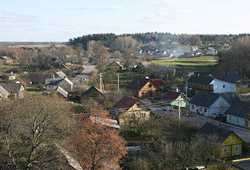History
The founding patron of the Pivašiūnai Church of the Assumption of the Blessed Virgin Mary was Jonas Klockis, a Kaunas city official, member of parliament and elder of the town of Medilas. In a 1633 testament, he left the Benedictine monks of Old Trakai a large sum of money and the Pivašiūnai estate. The Benedictines took care of the Pivašiūnai church for more than two centuries, right up until the closure of their monastery in Old Trakai in 1845. The current wooden church in the shape of a Latin cross is the third at Pivašiūnai. It was built in 1825 thanks to the efforts of Benedictine Abbot Celestine Sorakas.
The miraculous image of the Mother of God dates back to the church’s foundation. It may have been commissioned by Jonas Klockis, who was a fervent devotee of the Virgin Mary, or else by the Old Trakai Benedictines. The painting does bear a strong likeness to the image of Mary in Old Trakai. And it has never failed to help pilgrims experience how God’s grace can revitalize both soul and body. In 1988, Cardinal Vincentas Sladkevičius honoured the Blessed Virgin and thanked God for the many graces obtained through her intercession by adorning the image of Our Lady of Pivašiūnai with crowns blessed by Pope John Paul II and naming her “Comfort of the Afflicted”.
Crowds of devout souls have always gathered for indulgenced feasts at Pivašiūnai, including commemorations of Mary’s Assumption to Heaven and birthday, and of St John the Baptist. Over time the Assumption of the Blessed Virgin, which is the church’s titular feast, came to dominate as the primary annual indulgenced feast here. The feast of the Assumption presently is celebrated over eight days and attracts pilgrims not only from Lithuania, but also from foreign countries.








